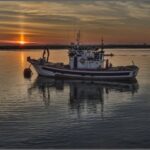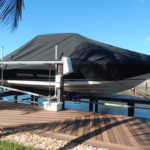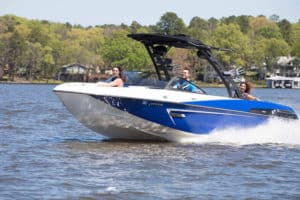With more and more Americans enjoying recreational boating, it is important that you know the laws before heading out. In this article, I’ll list the important things you need on a boat by law.
For boats less than 16 feet, such as canoes and kayaks, to vessels that are 26 to 40 feet, here are 9 things you need on a boat by law:
- Personal Flotation Devices (PFD): NRS cVest Mesh Back PFD – Click here to see it on Amazon – Our #1 Top Pick!
- State Registration
- State Numbering and Letters
- Visual Distress Signals
- Sound Producing Devices
- Fire Extinguishers
- Backfire Flame Arrestor
- Marine Sanitation Devices
- Ventilation
For larger vessels, you would also need to have a copy of The Inland Navigation Rules on board at all times.
Despite the reduction in boating injuries and deaths, property damage in boating accidents still amount to $45.99 million in 2017. To avoid being part of that statistic, make sure you have all the required items on your boat.
Read on to learn more about the 9 important things you need on a boat by law.
Also, we hope you find the links here useful. We may get a commission if you purchase something through a link on this page, so thank you!
Also, for an excellent life vest, take a look at our top pick, the NRS cVest Mesh Back PFD:
Click here to see it on Amazon.
9 Important Things You Need on a Boat by Law
1. Personal Flotation Devices (PFD)
Regardless of the size of your vessel, there should be an allotted Type I, II, or III PFD or life vest for each passenger and an additional throwable Type IV PFD’s.
Most of today, if not all available life jackets, still bear the “Type” codes; however, these codes will be a thing of the past as per the U.S. Coast Guard.
They intend to label the PFD’s with icon-based labels that shows buoyancy. Don’t panic just yet. Despite the code change, you may still use your “Type” labeled life jackets as long as they are well maintained and serviceable.
Personal Flotation Devices are an integral part of your safety, specifically when you are out on the water. In 2017, 84% of the 76% percent of drowning incidents were due to a lack of life jackets.
As we recommended in another article we wrote on PFDs, the NRS cVest Mesh Back PFD is a reliable life jacket that’s handy when you are enjoying a fishing trip.
It is a great investment that will keep you comfortable and safe on each boating trip. The NRS cVest Mesh jacket is also customizable for a perfect fit and has several storage pockets.
Click here to see it on Amazon.
2. State Registration
Recreational boats are required to be registered in the state where they are commonly used.
Once you have registered your vessel, the state will provide you a “Certificate Number” that must be on board at all times while the boat is in use. You also have an option to have your boat registered with the Coast Guard.
3. State Numbering and Letters
Once you have registered your vessel, you will attach the “Certificate Number” on each side of your boat’s forward half to make it visible. Remember that to maintain the number’s visibility, its color must be in contrast with the boat and be at least 3 inches in height.
The provided validation sticker must also be placed within six inches of the registration numbers. Think of these numbers like a car’s license plate. They must be visible with no obstructions at all times for your safety and others.
4. Visual Distress Signals
You must have night signals when operating at night. These signals can only be used within 42 months from the manufacturing date.
Boats 16 to 26 feet are advised to have one of the following pairs of distress signal devices on board:
- 1 orange distress flag and 1 electric distress light
- 3 hand-held or floating orange smoke signals and 1 electric distress light
- 3 pairs of day and night red flares that can either be hand-held, parachute-type, or meteor
The Sirius Signal SOS LED Electronic Visual Distress Signal uses an LED light that can be seen up to 10 nautical miles away from you.
Click here to see it on Amazon.
Its patented lenses shine both horizontally and vertically for maximum visibility day or night. As one of the best electronic distress signals in the market, it can flash up to 60 hours.
5. Sound-Producing Devices
When you are out on the water, creating sufficient sound when crossing, overtaking, or meeting other vessels is necessary. In instances such as these, no human-produced sound will suffice. That is why you need the help of whistles and horns.
If you are looking for a reliable air horn, the Shoreline Marine Air Horn is a great investment.
Not only does it meet the U.S. Coast Guards’ standards, but it is also non-flammable with a 120-decibel volume that can be heard up to a mile away.
6. Fire Extinguishers
Vessels with enclosed living spaces, enclosed engine compartments, permanent fuel tanks, or have flammable and highly combustible materials must have a fire extinguisher.
For boats 16 to less than 26 feet, one B-I-approved hand portable fire extinguisher will suffice; however, you will need two B-I types or one B-II portable extinguisher for larger vessels.
7. Backfire Flame Arrestor
Modern boats are required to have a way of controlling backfire flames. For each carburetor of all gasoline-powered vessels, one Coast Guard-approved device is required by law.
8. Marine Sanitation Devices
For larger vessels with an onboard toilet, the law requires you to have a Coast Guard-certified Type I or Type II flow-through or Type III holding tank as a marine sanitation device. This ensures that the excrement will not harm or pollute marine biodiversity.
9. Ventilation
For boats built after 1940 with an enclosed gasoline engine or fuel tank, you are required by law to have natural ventilation. For vessels created after 1980, there must be an exhaust blower.
To efficiently ventilate the bilges of closed engine and fuel tank compartments, at least two ventilation ducts with fitted cowls are required.
5 Things That Aren’t Required by Law but Are Good to Have on Your Boat
The things you need on a boat by law have one purpose: to ensure safety. These things provide you the ease of mind that you are 100% prepared for any situation. Other than these mandatory items, here is a list of things that would be handy on any boating trip:
1. First Aid Kits
From small cuts to life-threatening incidents, the first few minutes are the most crucial. Have a first aid kit on board every time you are out on the water to address common injuries. This can help you save a life until you dock or paramedics arrive.
The Goglobe Boat Safety Kit for Boating includes all the minimum safety requirements for boating.
Click here to see it on Amazon.
It includes 60 feet of floatable rope, strobe light, distress flag, signal mirror, a 12-function multitool, and a rescue whistle.
2. Sun Protection
Too much sun is bad for your skin. Use an ample amount of sunblock. If you plan to have a refreshing dip in the water while you are out on your boating trip, be aware, and choose a coral-safe sunblock.
Click here to see it on Amazon.
By doing so, you can enjoy your time and the sun without damaging the environment’s natural ecology.
3. Extra Fuel
It is extremely troublesome to be stuck in the middle of a boating trip because of the lack of fuel. So make sure you have enough. Should you want to be extra cautious and store some extra fuel, make sure to use certified and proper containers. Also, remember to store any extra fuel containers responsibly, away from any open burning or sparks.
4. Radios
The best way to ask for help when you are on the water is by using a radio. Your cellular phone won’t always be reliable, especially if you are on open water or fishing far from neighboring towns. Always have a reliable radio with you.
5. Tool Kit
One of the leading reasons behind boating injuries is mechanical failure. Make sure you have a handy tool kit ready with the necessary tools for immediate repairs. It never hurts to be extra cautious.
Conclusion – 9 Items Required on a Boat By Law
To have a fun and easy-going boating trip, always keep yours and everyone else’s safety a top priority. Having a safe trip means equipping yourself with all the things you need on a boat by law and learning how to use these items properly.
Be responsible and do a full checklist of what you have in your boat before going out to the water. Always have the following items on board with you before using your boat:
- Personal Flotation Devices (PFD): NRS cVest Mesh Back PFD – Click here to see it on Amazon – Our #1 Top Pick!
- State Registration
- State Numbering and Letters
- Visual Distress Signals
- Sound Producing Devices
- Fire Extinguishers
- Backfire Flame Arrestor
- Marine Sanitation Devices
- Ventilation
Regardless of what kind of boating adventure you have in mind, these are the basic devices you need to have on you at all times. They are not just required by law but are very practical and useful to have in your boat.
Abiding by the law means having a worry-free adventure. Be responsible and observant of your surroundings to prepare you for any situation you might encounter. It never hurts to be prepared and cautious.
Make sure to double-check your vessel for any corrosion, leaks, or lack of equipment today, and enjoy great peace of mind on the water!
Related reading:
Best Life Jacket for Bass Fishing – Our Top 5 Picks
What Are the Boat Requirements in Arkansas?










![Boat Floor Replacement Plywood [Best Options] boat floor replacement plywood](https://boatinggeeks.com/wp-content/uploads/2021/07/boat-floor-replacement-plywood-150x150.jpg)


